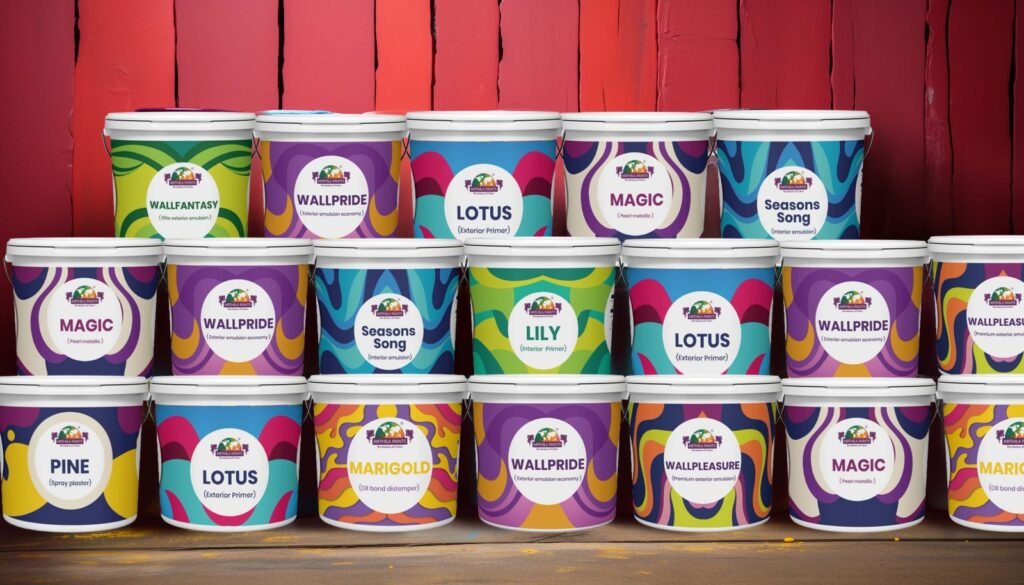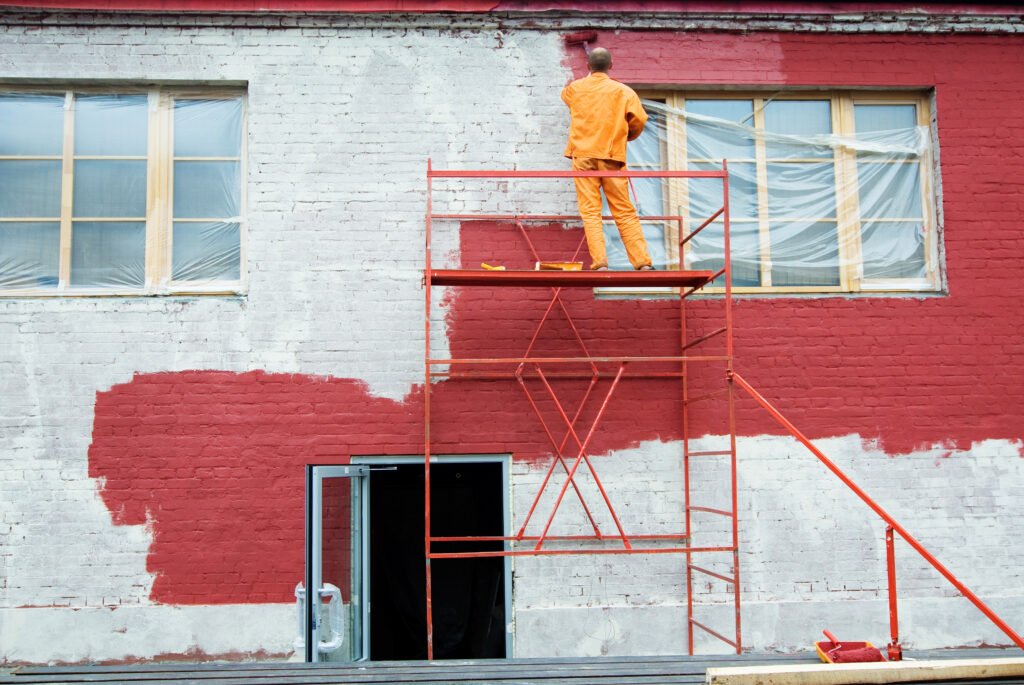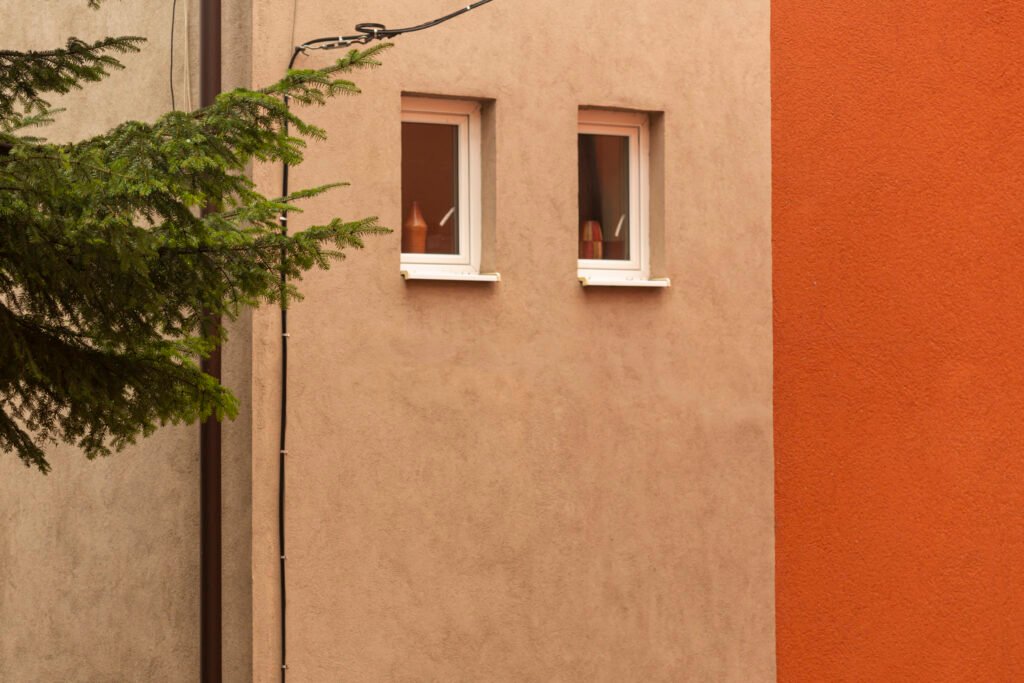Introduction to Exterior Wall Paint
When considering home improvement projects, exterior wall paint is often a significant yet rewarding undertaking. The importance of choosing the right exterior wall paint cannot be overstated, as it plays a crucial role in both the aesthetics and the functionality of a building. A fresh coat of wall paint can transform the appearance of a home, enhancing its curb appeal and potentially increasing its market value. Beyond the visual upgrade, exterior wall paint serves a protective purpose by shielding the walls from various environmental factors, such as moisture, UV rays, and extreme weather conditions.
Environmental damage is a substantial concern for homeowners and property managers. Water infiltration, for instance, can lead to mold growth and structural issues, while prolonged sun exposure can cause fading, cracking, and peeling of wall surfaces. Quality exterior wall paint forms a barrier that repels moisture and resists the deteriorating effects of ultraviolet light, significantly prolonging the lifespan of a building’s exterior. This protective layer reduces the need for frequent repairs and maintenance, resulting in long-term cost savings.
The aesthetic advantages of exterior wall paint are equally important. A well-chosen color scheme can highlight architectural features, reflect personal style, and harmonize with the natural surroundings. With an extensive palette of colors and finishes available, homeowners can select hues that express their personality while complying with local regulations or homeowners association requirements. Moreover, modern paints offer innovations like fade resistance and self-cleaning properties, ensuring the building maintains a fresh appearance for years to come.
In essence, exterior wall paint is more than just a decorative element; it is a vital component that merges beauty with functionality. By providing protection against environmental damage and enhancing visual appeal, the right exterior wall paint ensures a building stands the test of time, looking vibrant and well-maintained.
Types of Exterior Paint
When selecting the appropriate exterior wall paint, it is crucial to understand the different types available and their respective advantages and disadvantages. The primary categories include latex, oil-based, and specialty paints such as elastomeric and masonry paints. Each type caters to specific wall materials and climate conditions, ensuring optimal performance and durability.
Latex paint, also known as water-based paint, is the most popular choice for exterior surfaces. Its flexibility allows it to expand and contract with the wall material, making it resistant to cracking in varying weather conditions. Additionally, latex paint dries quickly and emits fewer volatile organic compounds (VOCs), rendering it an environmentally friendly option. However, it may not adhere well to surfaces previously painted with oil-based paint and can be less durable against heavy wear and tear.
Oil-based paint, on the other hand, offers excellent adhesion and a robust finish, making it suitable for high-traffic areas and surfaces exposed to harsh environmental factors. This paint provides a smooth, glossy appearance and is more resistant to moisture, making it ideal for humid climates. The drawbacks of oil-based paint include a longer drying time and higher VOC emission, necessitating thorough ventilation during application. Additionally, cleanup requires mineral spirits or turpentine.
Specialty paints, such as elastomeric and masonry paints, offer targeted solutions for unique surfaces. Elastomeric paint is specifically designed for exterior walls exposed to heavy weathering and is highly flexible, allowing it to bridge small cracks and gaps in the substrate. It is particularly effective on stucco and concrete surfaces. Meanwhile, masonry paint is formulated to penetrate and protect porous materials like brick and stone, providing excellent adhesion and weather resistance. These specialized options may come at a higher cost but deliver enhanced performance tailored to specific needs.
By understanding the characteristics and uses of each type of exterior paint, homeowners can make informed decisions that suit their specific wall materials and climate conditions, ensuring lasting beauty and protection for their exterior surfaces.

Choosing the Right Color and Finish
When selecting the perfect exterior wall paint, the choices of color and finish are paramount. The paint color should not only enhance your home’s aesthetic appeal but also resonate with its architectural style. Consider the overall design of your home, taking into account elements like the roof, window frames, and surrounding landscape. Traditional homes may look best in classic hues such as whites, beiges, or muted pastels, while modern designs might call for bold, stark colors, or even monochromatic schemes.
Beyond personal preference, it’s crucial to factor in your neighborhood’s palette. A harmonious integration with nearby homes ensures your property blends seamlessly into the community, adhering to any potential homeowner association guidelines. Additionally, local environmental factors play a significant role; lighter shades reflect heat and are often preferred in warmer climates, while darker tones can provide a cozy, insulated appearance suitable for cooler regions.
Alongside color, the finish of the wall paint significantly influences the overall outcome. Each type of finish has unique characteristics that impact both the look and the durability of the exterior surfaces. Matte finishes provide a non-reflective, sophisticated look, ideal for hiding imperfections on wall surfaces. However, they may not be as durable as glossy finishes, which offer a vibrant, shiny appearance and exceptional resistance to weather and wear.
Satin finishes stand as a versatile middle ground, offering a subtle sheen that adds depth and elegance while balancing durability and ease of maintenance. They are less reflective than gloss but sturdier than matte, making them a popular choice for many homeowners. It is essential to evaluate the specific conditions your wall paint will face, including exposure to sunlight, precipitation, and physical abrasions, to choose a finish that promises longevity and maintains aesthetic appeal.
Ultimately, the right combination of color and finish can elevate your home’s exterior, providing not only a visually pleasing facade but also safeguarding against the elements. Thoughtful consideration of aesthetic harmony and functional durability ensures your chosen wall paint serves as a lasting adornment for your property.

Preparing Exterior Walls for Painting
Proper preparation of exterior walls is a crucial step in the wall paint application process that cannot be overlooked. A meticulous approach ensures not only a smooth application but also the longevity of the paint job. The first step in preparing exterior walls for painting involves thorough cleaning. This can be achieved by using a pressure washer to remove dirt, mildew, and loose debris. Allow adequate drying time to prevent trapping moisture under the paint, which can lead to peeling and bubbling.
Once the walls are clean, the next step is scraping off old, flaking paint. Utilizing a scraper or wire brush, ensure all loose paint is removed. For more stubborn areas, you may need to use a heat gun, taking care to avoid damaging the underlying wall surface. It’s essential to perform this step diligently to create a smooth base for the new wall paint.
Addressing cracks and surface damages is another critical aspect of wall preparation. Inspect the walls for any cracks, chipped areas, or holes. Use a high-quality exterior filler or putty to repair these imperfections, allowing it to dry completely before sanding it smooth. This will ensure an even application and an aesthetically pleasing finish.
Priming the exterior walls is the final step in the preparation process. Primer acts as a base coat that improves the adhesion of the wall paint and adds an additional layer of protection against weather elements. Choose a primer that is suitable for your wall type—whether it’s wood, stucco, or brick. Apply the primer evenly and allow it to cure as recommended by the manufacturer before proceeding with the top coat of paint.
A comprehensive preparation process plays a pivotal role in the success of any exterior painting project. By meticulously cleaning, scraping, repairing, and priming the walls, you ensure a professional finish that stands the test of time, ultimately enhancing the protective and aesthetic qualities of your chosen wall paint.

Tools and Materials Needed
Embarking on a project to paint exterior walls requires a well-thought-out selection of tools and materials to ensure efficiency and quality results. Among the essential tools for this task are paintbrushes, which are particularly useful for cutting in edges and painting small or intricate areas. It’s crucial to select brushes with high-quality bristles that can hold a decent amount of wall paint, providing smooth and even coverage.
Rollers, ideally with a long handle, are indispensable for covering large surface areas quickly. The choice of roller nap (or thickness) depends on the texture of the wall; thicker naps are suitable for rough surfaces while thinner ones work best on smooth walls. Rollers, just like brushes, should be of good quality to minimize drips and ensure an even application of the exterior wall paint.
Drop cloths or plastic sheeting are non-negotiable when it comes to protecting the ground, plants, and any other surfaces from accidental paint splashes. Their placement should be strategic, covering all areas where paint might stray during the application process.
Painters’ tape is another critical tool, used to mask off areas that need protection, like window frames, doors, and trim. It ensures clean, sharp lines and prevents the wall paint from bleeding into unintended areas. Always go for high-quality painter’s tape to avoid residue and ensure easy removal after painting.
Ladders and scaffolding are necessary for safely reaching higher sections of exterior walls. It’s important to use stable, well-maintained ladders and follow safety precautions to avoid accidents. For those who prefer a more uniform finish or need to cover vast areas quickly, sprayers are a valuable addition. They offer a faster application time and can sometimes provide a more even coat than rollers or brushes, especially on textured surfaces.
Lastly, don’t forget about the paint itself. Choosing the right type of exterior wall paint is paramount for durability and aesthetics. Opt for paints that are specifically formulated to withstand weather conditions and offer resistance to fading, mildew, and peeling. With the right tools and materials, painting exterior walls can become a manageable and rewarding project.
Step-by-Step Painting Process
Successfully painting exterior walls involves a methodical approach to ensure an even, professional finish. This step-by-step guide will walk you through the necessary techniques for applying wall paint, including essential practices like cutting in at corners, rolling large surfaces, and applying multiple coats. These steps will also highlight common pitfalls to avoid, ensuring a flawless outcome for your exterior wall paint project.
Cutting in at Edges and Corners
Begin by cutting in around edges and corners using an angled brush. This process involves carefully painting the areas where a roller cannot reach, such as the edges near trims, windows, and under eaves. Dip the brush into the paint, and offload any excess by tapping it gently against the side of the can. Steadily guide the brush along the edge, maintaining a few inches of clearance between the wall and any borders. This deliberate precision prevents drips and ensures clean lines. The key is patience; rushing this step could lead to irregular edges that will detract from the overall finish.
Rolling Large Surfaces
After the cutting in, use a paint roller for larger surface areas. Pour your wall paint into a tray and evenly load the roller by rolling it in the paint then removing any excess on the tray’s ridges. Apply the paint using a “W” or “M” pattern to cover large sections without creating unintentional streaks. Overlap slightly with the cut-in areas to blend edges seamlessly. Maintain an even pressure to avoid roller marks. Work systematically from top to bottom and ensure consistent coverage before the paint starts to dry.
Applying Multiple Coats
Applying multiple coats is crucial for achieving an even, long-lasting finish. Allow the first coat to dry completely before adding a subsequent layer, following the manufacturer’s drying time recommendations. Typically, two to three coats are sufficient, but highly porous surfaces or dramatic color changes may require additional layers. Lightly sanding between coats with fine-grit sandpaper helps smooth out imperfections and provides better adhesion for subsequent coats. Remember, patience during drying phases can significantly enhance the final appearance of your wall paint.
Common Mistakes to Avoid
To ensure a professional finish, be mindful of common pitfalls such as painting in extreme temperatures, which can affect paint consistency and drying time. Avoid overloading brushes or rollers to prevent drips and irregular textures. Adequately preparing your walls by cleaning, repairing cracks, and applying a primer will also improve adhesion and durability of your wall paint. Lastly, using quality materials and tools can make a notable difference; inferior products often result in uneven application and diminished longevity.
Maintenance and Care of Painted Exterior Walls
Maintaining your exterior wall paint is crucial to prolonging its lifespan and preserving the aesthetic appeal of your property. Effective maintenance involves regular inspection, cleaning, and prompt addressing of any minor damages. Here, we delve into the best practices for keeping your painted exterior walls in top-notch condition.
Firstly, periodic inspection of the walls is essential. At least twice a year, carefully examine the painted surfaces for signs of wear and tear, such as peeling, cracking, or fading. Early detection allows for timely intervention, which can prevent more extensive and costly repairs. Additionally, identifying any issues promptly will help you preserve the integrity of the wall paint and the underlying structure.
Cleaning the exterior walls is another important aspect of maintenance. Dust, dirt, and pollutants can accumulate on the wall surface, dulling the paint’s appearance. Use a soft-bristled brush or a pressure washer set to a low setting to gently clean the walls. Avoid harsh chemicals as they can damage the paint. A mild detergent mixed with water is usually sufficient for most cleaning tasks. Ensure you rinse thoroughly to prevent any soapy residue from attracting more dirt.
Addressing minor damages as soon as they appear can greatly extend the life of your wall paint. For small chips or cracks, carefully remove any loose paint and apply a suitable exterior filler. Once it dries, sand it smooth, and repaint the area with a matching paint to blend seamlessly with the surrounding surface. This practice not only maintains the visual appeal but also protects the walls from moisture and other environmental elements.
Repainting may become necessary every few years, depending on the paint quality and exposure to elements. Observe your walls regularly and consult a professional painter to assess when it is best to undertake repainting. High-quality paints tend to withstand weather conditions better, thus extending the repainting cycle.
Lastly, protecting wall paint from harsh weather conditions is pivotal. Consider applying a weather-resistant coating to provide an additional layer of protection against UV rays, rain, and temperature fluctuations. Covering vulnerable areas with water-resistant materials during severe weather can also minimize damage.
Consistent maintenance and timely care contribute significantly to the durability and beauty of your exterior wall paint. By following these best practices, you can ensure your painted walls remain vibrant and resilient for years to come.
Common Issues and Troubleshooting
Exterior wall paint can sometimes present a series of issues, even when applied with the utmost care. Among the most common challenges faced are peeling, blistering, and fading. Understanding these problems and knowing how to address them is crucial for maintaining the aesthetic and protective qualities of your wall paint.
Peeling paint often results from moisture seeping behind the paint layer, leading to a loss of adhesion. This can be caused by leaks, condensation, or inadequate surface preparation. To troubleshoot peeling, first, inspect the area for moisture sources and rectify them. Remove the peeling paint by scraping or sanding, clean the surface thoroughly, and allow it to dry completely. Apply a high-quality primer and finish with a fresh coat of durable exterior wall paint.
Blistering, characterized by bubbles or blisters forming on the paint surface, is usually due to painting under unsuitable conditions. High heat, intense sunlight, or painting over a damp surface can trap moisture or cause the paint to cure too quickly. To fix blistering, scrape off the blistered paint, sand the area smooth, and ensure the surface is dry and cool before repainting. Use paints designed to perform well in varying weather conditions to prevent future blistering.
Fading, the gradual loss of paint color, is often a result of prolonged exposure to ultraviolet (UV) rays. Low-quality paints are more susceptible to fading. When addressing fading, consider repainting with a high-quality, UV-resistant exterior wall paint. Regular maintenance, including periodic washing to remove dirt and mildew, can further protect the paint from environmental damage.
To avoid these issues from the onset, invest in high-quality materials and follow recommended application guidelines. Ensure proper surface preparation, appropriate weather conditions for painting, and allow sufficient drying time between coats. Regular maintenance and inspections can help in identifying potential problems early, ensuring that your exterior wall paint remains in top condition.


Если нужны тематические площадки, выбирайте базы форумов xrumer https://www.olx.ua/d/uk/obyavlenie/progon-hrumerom-dr-50-po-ahrefs-uvelichu-reyting-domena-IDXnHrG.html, соответствующие вашей нише.
Особенно понравился последний обзор шин в Авто новости ШинаПро. Очень подробно и понятно.
Я звертаю увагу на формати, що подають podii стисло та чітко. Це спрощує сприйняття.